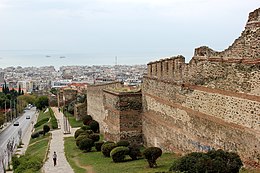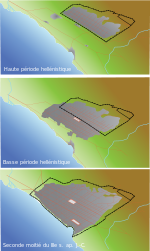
Back Солунски стени Bulgarian Byzantinische Stadtmauer (Thessaloniki) German Βυζαντινά τείχη της Θεσσαλονίκης Greek Murallas de Salónica Spanish دیوارهای سالونیک Persian Thessalonikin kaupunginmuuri Finnish Murs d'enceinte de Salonique French Byzantynske stedsmuorre (Tessaloniki) Frisian Солунски ѕидини Macedonian Mestno obzidje Soluna Slovenian
This article includes a list of general references, but it lacks sufficient corresponding inline citations. (November 2022) |
| UNESCO World Heritage Site | |
|---|---|
 The eastern walls | |
| Location | Thessaloniki, Greece |
| Part of | Paleochristian and Byzantine Monuments of Thessaloniki |
| Criteria | Cultural: i, ii, iv |
| Reference | 456-002 |
| Inscription | 1988 (12th Session) |
| Coordinates | 40°38′33″N 22°57′16″E / 40.64250°N 22.95444°E |
The Walls of Thessaloniki (Greek: Τείχη της Θεσσαλονίκης, Teíchi tis Thessaloníkis) are the 4 kilometer-long city walls surrounding the city of Thessaloniki during the Middle Ages and until the late 19th century, when large parts of the walls, including the entire seaward section, were demolished as part of the Ottoman authorities' restructuring of Thessaloniki's urban fabric. The city was fortified from its establishment in the late 4th century BC, but the present walls date from the early Byzantine period, ca. 390, and incorporate parts of an earlier, late 3rd-century wall. The walls consist of the typical late Roman mixed construction of ashlar masonry alternating with bands of brick. The northern part of the walls adjoins the acropolis of the city, which formed a separate fortified enceinte, and within it lies another citadel, the Heptapyrgion (Seven Towers), popularly known by the Ottoman translation of the name, Yedi Kule.
In 1988, as part of the Paleochristian and Byzantine monuments of Thessaloniki, the walls were added to the UNESCO World Heritage List because of their outstanding Byzantine architecture.[1]
- ^ "Paleochristian and Byzantine monuments of Thessaloniki". UNESCO World Heritage Convention. United Nations Educational, Scientific, and Cultural Organization. Archived from the original on 5 January 2021. Retrieved 5 November 2022.


